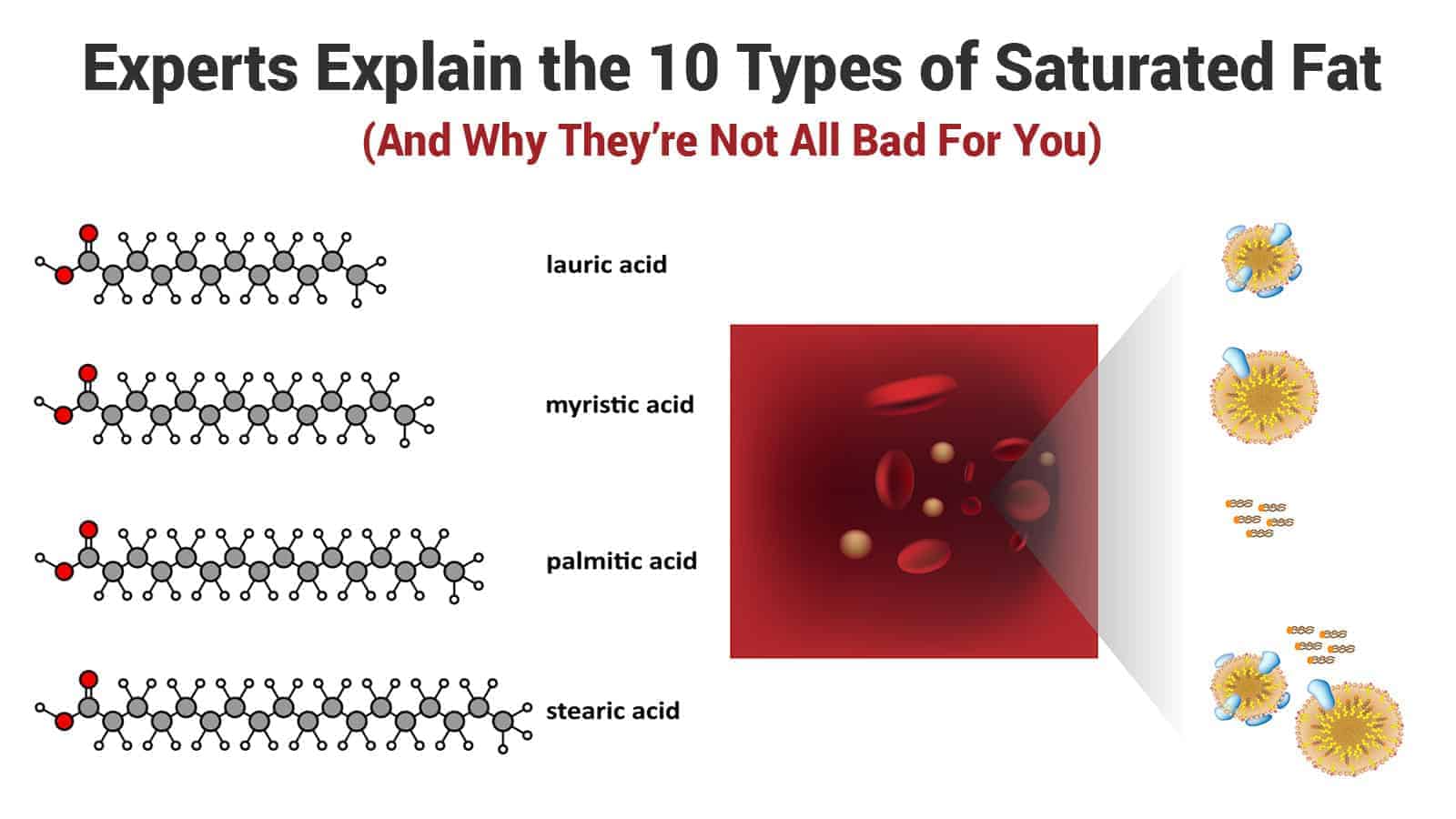When one thinks of fat, usually thoughts of weight gain follow, as well as all the unhealthy consequences that come along with it. Saturated fats have been a topic of controversy for quite some time.
Until very recently, many considered this fat one of the leading contributing factors to people developing heart disease. Nowadays, though, scientists question this assumption. People are also beginning to actually seek out saturated fat for health benefits!
What is clear, though, is that saturated fats are not just one specific nutrient; Saturated fats include a grouping of a variety of different fatty acids which all have their own effects on our bodies.
To help you understand this fat a bit more, we will provide a description of the various different types of saturated fat you might encounter. Continue reading to learn more:
What Is Saturated Fat?
There are two different main classifications of fat, one is saturated fat, and the other, unsaturated fat. These two fat groupings differ in their chemical properties and structure in minor ways. For instance, while unsaturated fat remains liquid at room temperature, saturated fats usually remain solid.
Good examples of this include cheese, butter, fatty meat, tallow, lard, cream, palm oil, coconut oil, and cocoa butter.
The most common saturated fats consumed in a normal diet include:
- Stearic Acid
- Palmitic Acid
- Myristic Acid
- Lauric Acid
- Capric Acid
- Caprylic Acid
- Caproic Acid
How Does Saturated Fat Affect Health?
Scientists nowadays generally accept that saturated fats are not the unhealthy fat once demonized as causing many of our health ailments.
Plenty of evidence shows that these fats do not, in fact, cause heart disease, as once thought.
It is still commonly believed though that replacing saturated fats with unsaturated fats may improve your heart health, and reduce your risk of having a heart attack. From this, it is easy to assume that saturated fats must be bad then. In fact, this only tells us that unsaturated fats are protective in nature, where saturated fats are neutral when it comes to heart health.
Types Of Saturated Fat:
1. Stearic Acid
Stearic acid, a type of fatty acid, contains 18 carbon atoms. It is the second most commonly consumed saturated fatty acid in a typical American diet.
When compared to other saturated fats or carbs, stearic acid has the ability lower LDL, or “bad,” cholesterol ever so slightly. Because of this, it may be seen as one of the healthier saturated fats one might consume.
Some studies show that this fatty acid is converted, at least in part, to oleic acid. Oleic acid is a healthy unsaturated fat that occurs naturally in your body. In estimation, though, only 14% of stearic acid converts to oleic acid; therefore, its effects aren’t necessarily that strong.
Probably the best source of stearic acid is from animal fats. It’s often hard to find this acid in meaningful quantities from plant sources, with the exception of cocoa butter, palm kernel, or coconut oil.
Of the different types of saturated fats, stearic acid is to be considered the best saturated fat for health. It likely will not raise your risk of developing heart disease, even for those who eat diets especially high in stearic acid.
2. Palmitic Acid
The most common of the saturated fatty acids found in both plants and animals is palmitic acid. Back in 1999, this acid made up over 56% of the total fat consumption of the population of the United States!
Of all the different sources of palmitic acid, palm oil is the most concentrated. Of the saturated fats found in dairy and red meat, it makes up roughly one quarter.
When compared to unsaturated fats or carbs, this fatty acid raises LDL and total cholesterol without negatively affecting your levels of HDL, or “good,” cholesterol.
Elevated levels of LDL cholesterol provide one of the best indicators of heart disease risk. Not all LDL is the same though; a better indicator of heart disease risk is the occurrence of high-frequency LDL particles, and also smaller, denser LDL particles.
Even though this fatty acid may raise your levels of LDL cholesterol, it is mostly because of an increase in levels of these larger LDL particles. Many researchers now believe that higher levels of these larger LDL particles should not cause concern. This is still up for debate.
Also, when fatty acids, like linoleic acid, are eaten in combination with palmitic acid, they can negate some of its negative effects on your cholesterol levels.
Palmitic acid is also believed to negatively affect areas of one’s metabolism. In recent research done on both humans, and mice, a diet high in palmitic acid reduced the occurrence of physical activity and also negatively affected dieters’ moods.
Multiple studies done on humans have found that diets high in palmitic acid can end up reducing the number of calories burned by the individual.
3. Myristic Acid
Myristic acid is known to cause a large increase in LDL and total cholesterol, in comparison to consuming carbs or palmitic acid. It is believed, however, to not affect HDL cholesterol levels.
The effects of myristic acid are much more pronounced than those of palmitic acid. In the same vein as palmitic acid, this fatty acid increases levels of large LDL particles which, as previously stated, isn’t too concerning.
This acid is rarely consumed as a part of a normal diet and isn’t found in high concentrations in most food items. Some fats and oils which do contain this fat include palm kernel and coconut oil, though they also contain more beneficial fatty acids which negate myristic acid’s negative effects.
4. Lauric Acid
Of the medium-chain fatty acids, lauric acid is the longest.
More than any other of the fatty acids, lauric acid raises total cholesterol. This large increase is due mostly to an increase in your HDL, or “good,” cholesterol, though.
Relative to your good cholesterol levels, lauric acid reduces your total cholesterol levels! This all works to actually lower your risk of developing heart disease!
Of all the saturated fatty acids, lauric acid is believed to most beneficial to your HDL cholesterol levels. Lauric acid makes up a large portion of both coconut oil and palm kernel oil. Most other oils only contain small amounts of lauric acid.
5. Caprylic Acid
Caprylic acid is considered a medium-chain fatty acid. It’s name comes from the Latin term for a female goat, which is “capra” because goat milk provides one of the best sources of Caprylic.
Long-chain and medium chain fatty acids are metabolized by our bodies differently. Medium-chain fatty acids are much easier for our bodies to absorb, and they are brought straight to our liver in order to be metabolized.
Some potential benefits of these medium-chain fatty acids include:
- Increased weight loss: Multiple studies show that a diet higher in medium-chain fatty acids (rather than long-chain) results in a slightly higher amount of calories burned throughout the day.
- Improved insulin sensitivity: Evidence also shows that medium-chain fatty acids have the amazing ability to increase our insulin sensitivity.
- Anti-seizure: Medium-chain fatty acids, in particular capric acid, is believed to offer anti-seizure effects, especially in conjunction with a ketogenic diet.
Of these medium-chain fatty acids, capric acid is the one most commonly consumed. Roughly 5% of palm kernel oil is capric acid, and 4% of coconut oil. It can be found in small amounts in some animal fats as well.
6. Caproic Acid
Caproic acid is another member of the “capra,” or medium-chain, fatty acid groupings. It functions similarly in the body to caprylic acid in that it bypasses the liver in order to metabolize quickly.
7. Capric Acid
Last of the “capra,” or medium-chain fatty acids is capric acid. In the same vein as the previously mentioned medium-chain fatty acids, this amazing fat can bypass your liver in order to provide you with a quicker source of energy. Capric, along with the previous 2 “capra” acids, give coconut oil its purported beneficial properties.
8. Butyric acid
Butyric acid, along with the next 2 fatty acids are members of what’s called the short-chain fatty acid grouping. These are considered short chain due to them containing fewer than 6 atoms of carbon.
Of the many short-chain fatty acids, the most prominent are:
- Butyric acid
- Propionic acid
- Acetic acid
These types of fatty acids are formed when the healthy bacteria in your gut ferments the fiber you consume in your colon.
Most of your body’s exposure to these types of fatty acids will be from what’s produced in your colon, not from dietary intake. They are very uncommon in the wild and are only found in trace amounts in fermented foods and dairy fats.
When one thinks of the many health benefits of a high fiber diet, they are usually actually brought on as a result of the short-chain fatty acids produced as a result. As an example, butyric acid provides a vital source of energy for the cells that line the inside of your colon.
The type of fiber that increases the occurrence of short-chain fatty acids in your colon is called prebiotic fiber. Prebiotic fibers include pectin, inulin, resistant starch, and arabinoxylan.
9. Propionic Acid
Propionic acid, another standout member of the short-chain fatty acid grouping, also naturally occurs as a result of the digestion and fermentation of food in your gut. Similar to butyric acid, the best way to get more propionic acid in your diet is to up your fiber intake.
10. Acetic Acid
Last, but not least, is acetic acid. This short-chain fatty acid is what gives vinegar its characteristic sour smell! In fact, white vinegar is simply a dilution of acetic acid. Besides making for a great cleaning product, acetic acid offers you benefits in the same vein as the other short-chain fatty acids. If you’re looking to expose your body to more acetic acid, without downing pints of vinegar, consider upping your fiber intake in order to supplement your body’s acetic acid intake.
FINAL THOUGHTS ON SATURATED FAT FOR HEALTH
It is easy to see why people are now seeking out saturated fat for health benefits. Saturated fat is not the heart attack causing devil it was once believed to be.
While not all types of saturated fats provide benefits, most do offer some benefits. At worst, they tend to be only neutral to our health. With continued research, more and more evidence points to saturated fats as a perfectly safe and healthy source of nutrition for your diet.














 Community
Community

